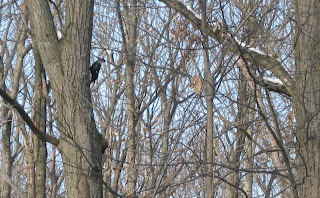
We had record snowfall in December. For the most part our new home behaved as it should. I "plowed" the snow a few times both during and after each storm with the new
Toro electric snow blower I picked up. I was a bit embarrassed about buying an electric snowblower for two reasons. Firstly, it means that I have given up using a shovel to clear the driveway. Lastly, few people around here would dare use an electric outdoor appliance. In these parts you either have someone plow you out regularly with a truck or you use a huge gas-powered snowblower. Now those two methods do work better, but the first one costs you per visit. The December storms would have already set me back about 2/3rds the cost of the Toro. A gas blower costs you quite a bit to buy and maintain. Even though it's mostly made of plastic, I chose the simple plug-in route, which for this model Consumer Reports says is OK, but not the best method if say you wanted to propel snow, ice, sticks, and rubble more than 50 feet in one fell swoop. An electric is much greener to run and does require zero maintenance, unlike a big gas guzzler. It seems to work, but there is a chance I'll have trouble if we get some heavy super slushy stuff, which admitably no snow-blower will like, followed by a temperature drop... or if I run over the cord. Whooops. Zzzzt.

As you may know, this winter we had at least two huge snow storms, a few large and a few small ones. We did not have any long periods of melt, so that snow piled up. Especially on one part of our roof which is flatter and smoother and actually colder (that's another story) than the rest. So it was about two weeks ago, that I noticed that the 18 inches of compacted snow and ice (from our almost 30 inch total snowfall) on that roof has started to move south.
What I mean is that all that frozen stuff on that rather shallow sloped membrane roof was moving. It was sliding off the roof. And since the gutter was filled with ice, it was even taking some of the gutter with it.

That veritable guillotine of a glacier was sitting up there. Hundreds of pounds precipitously positioned to imperil people. I warned my immediates to stay away and instructed them on how to safely peek up at it from under the screen porch.
They have these things up here called "ice dams". They are different, but interesting and troublesome nonetheless. If you have an ice dam, then you have a ridge of ice on the lower part of your roof just before the edge. Basically your roof is not well insulated, so the snow on top of the roof above your living area melts, while the water which runs off along the edge of your roof just over the eaves freezes. You get a build-up of ice around the edges until it blocks any melting water. Now you have an
ice dam. It's a pool of water on your roof. It can leak into your house or if it gets even colder it can freeze and mess with your roof tiles. Good thing I just have my roof glacier to deal with.
Another day went by and, as you can see, the roof glacier was now projecting about 3 1/2 feet out from the house. Icicles are supposed to dangle and glint and grow as they melt and freeze, but this was instead one slowly moving sturdy yet dangerous heavy shelf of ice. But it was very cold out, so it clearly wasn't going anywhere fast.
Two days ago we started to have our recent bout of mysterious Spring weather and a big thaw. In the middle of the day I heard a huge crashing, whomping sound from the yard when the whole thing fell off leaving a pile of snow and broken ice. An hour later, another 2 foot glacier was back - apparently slid down the roof - to take the place of the first. It too fell and again and again until now the roof is mostly clear. What remains is a bit of ice and a bent gutter.




